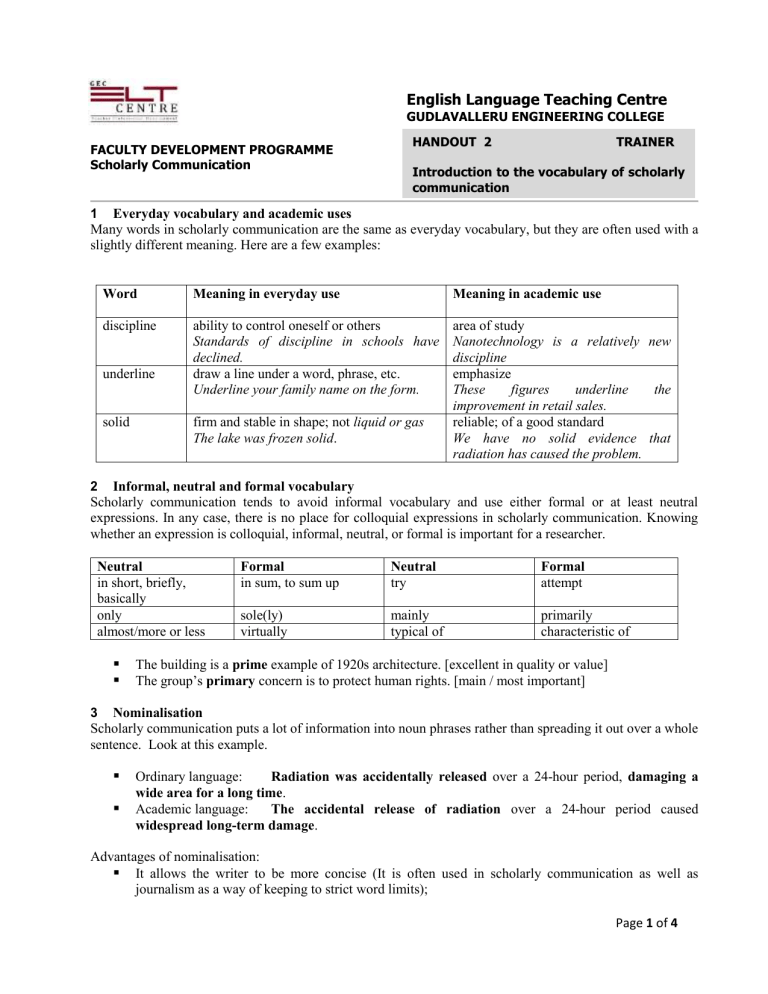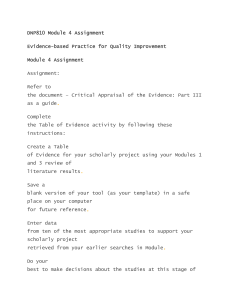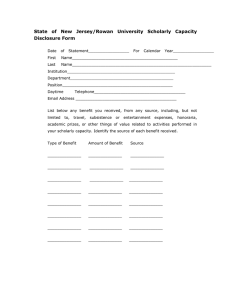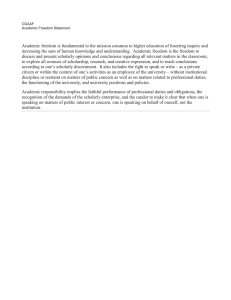
English Language Teaching Centre GUDLAVALLERU ENGINEERING COLLEGE FACULTY DEVELOPMENT PROGRAMME Scholarly Communication HANDOUT 2 TRAINER Introduction to the vocabulary of scholarly communication 1 Everyday vocabulary and academic uses Many words in scholarly communication are the same as everyday vocabulary, but they are often used with a slightly different meaning. Here are a few examples: Word Meaning in everyday use Meaning in academic use discipline ability to control oneself or others Standards of discipline in schools have declined. draw a line under a word, phrase, etc. Underline your family name on the form. area of study Nanotechnology is a relatively new discipline emphasize These figures underline the improvement in retail sales. reliable; of a good standard We have no solid evidence that radiation has caused the problem. underline solid firm and stable in shape; not liquid or gas The lake was frozen solid. 2 Informal, neutral and formal vocabulary Scholarly communication tends to avoid informal vocabulary and use either formal or at least neutral expressions. In any case, there is no place for colloquial expressions in scholarly communication. Knowing whether an expression is colloquial, informal, neutral, or formal is important for a researcher. Neutral in short, briefly, basically only almost/more or less Formal in sum, to sum up Neutral try Formal attempt sole(ly) virtually mainly typical of primarily characteristic of The building is a prime example of 1920s architecture. [excellent in quality or value] The group’s primary concern is to protect human rights. [main / most important] 3 Nominalisation Scholarly communication puts a lot of information into noun phrases rather than spreading it out over a whole sentence. Look at this example. Ordinary language: Radiation was accidentally released over a 24-hour period, damaging a wide area for a long time. Academic language: The accidental release of radiation over a 24-hour period caused widespread long-term damage. Advantages of nominalisation: It allows the writer to be more concise (It is often used in scholarly communication as well as journalism as a way of keeping to strict word limits); Page 1 of 4 4 It leads to more efficient writing; It can make a text sound more authoritative; and It can be used, like the passive voice, to hide agency (who carried out an action). Phrases frequently used in scholarly communication Just a few examples: in terms of in addition for the most part in the case of a great deal of a wide range of TASKS 1 Each word in the box can be used in two ways, one an everyday way, and the other a typically academic/scholarly way. Complete each pair of sentences using the same word for both sentences and making any necessary grammatical changes. generate turn solid underline character pose confirm identify nature focus a. She loves to pose for photographs in front of her fabulous house. The events pose a threat to stability in the region. b. It was difficult to focus the camera on the flower as it was so small. Attention should be focused on the more important issue of ecological awareness. c. I called the airline and confirmed my reservation. The data confirmed my hypothesis that animal-lovers can enjoy better health. d. The power plant generates electricity for the whole region. The issue always generates a great deal of debate among scholars. e. The murderer was identified from fingerprints discovered at the scene. In this theory of history, progress is closely identified with technology. f. She became interested in nature conservation. The first lecture in the series was on the nature of human communication g. Ram is a very interesting character. I hope you meet him. The book attempts to explain the fundamental character of social life. h. I saw her turn to her husband and whisper something in his ear. Let us now turn to the subject of town planning i. He always underlines every new word when he is reading. The study underlines the fact that very little research exists on the subject. j. The liquid became solid as the temperature was lowered. The study lacks solid evidence and therefore its conclusions are doubtful. Page 2 of 4 2 Use more formal alternatives to the words in bold. Make necessary grammatical changes. a. The book is mainly concerned with the problem of policing the internet. primarily b. Almost every school in the country had reported problems with the new system. Virtually c. The work of the Institute is not only devoted to cancer research. solely d. Basically, the study has demonstrated a significant link between the two events. In sum, To sum up, In summary e. We tried to find a new way of understanding the data. attempted f. The study is a really good example of the way sociologists collect their data. prime g. The reaction is typical of the way large corporations keep control of their markets. characteristic 3 Rewrite each sentence with a noun phrase related to the word in bold. Use a noun from the same family as the underlined word. (See 3. Nominalisation on page 1 before you attempt this exercise.) a. The World Wide Web has grown rapidly since it was created in 1991. The World Wide Web has grown rapidly since its creation in 1991. b. The model provides a framework to transcribe intonation and analyse it. The model provides a framework for the transcription and analysis of intonation. c. Producing food is an important source of income for this country. Food production is one of the most important sources of income for this country. d. Potter (1998) points out how important knowledge structures are in building critical analysis skills. Potter (1998) points out the importance of knowledge structures in building critical analysis skills. e. Improving what students understand about the way advertising works may have more potential for creating discerning consumers. Improving students’ understanding of how advertising works may have more potential for creating discerning consumers. f. Boush and Rose (1994) measured what middle-class students know about advertiser tactics and how skeptical they were of advertising. Boush and Rose (1994) measured middle-class students’ knowledge of advertiser tactics and their scepticism of advertising. g. Students also learn about the processes involved in how advertising messages are created. Students also learn about the processes involved in the creation of advertising messages. 4 The following are statements about a research report. Fill in the blanks in the statements with suitable phrases from the box. as a whole as opposed to a wide range of by means of due to for the most part for this reason in greater detail to a great extent with respect to Page 3 of 4 a. Joslav used an eight-point scale in the questionnaire, as opposed to a four-point one, by means of which he showed that attitudes covered a very wide range. b. Qualitative data obtained by means of meticulous physical observation supports the questionnaire data to a great extent. c. The researchers quote a wide range of sources. d. The study examined the issue in greater detail, in particular, from the point of view of the community. e. The community as a whole does not seem to care about crime and discipline. f. For the most part, the members of the community seem to see violence as something that is outside of them. g. The poor relationship between the parents and the children seems to be due to the fact that they do not spend enough time together. h. With respect to home life, parents should take more responsibility for their children. i. For this reason, we decided to repeat the experiment. Page 4 of 4

![Student%20Pharmacological%20Presentation%20Grading%20Rubric[1]](http://s2.studylib.net/store/data/026175754_1-094fe1e9bb7b5a27ca65ae9ddf796617-300x300.png)


